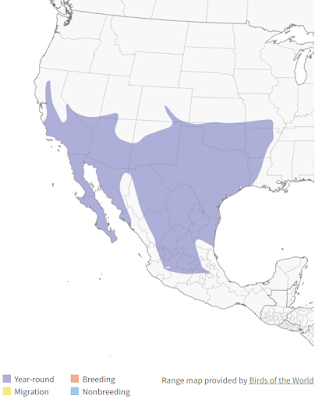I don’t know if you have watched the Warner Bros. animated series "Wile E. Coyote and the Road Runner". This pair of characters is an anthropomorphic animal coyote and roadrunner in appearance. The roadrunner with blue and purple feathers relies on its extremely fast sprint speed, "beep! beep!" cry and unreasonable good luck to avoid the capture by Wile E. Coyote. For me, it is funny to see or remember this scene every time. A few days ago (2023.03.15) surprisingly we actually saw a greater roadrunner crossing the road quickly. When we stopped the car and found it, it was eating a snake. I was so happy that I captured this rare scene. Does the greater roadrunner’s call really sound like “beep! beep!”? If you want to hear its call, you can go to this website to listen.
不知道你有沒有看過華納兄弟喜劇卡通影片《威利狼和嗶嗶鳥》,這一對角色外觀造型上是擬人化的動物郊狼及走鵑,嗶嗶鳥在外型上是有著淺藍及紫色羽毛的走鵑,它靠著快跑速度並發出「嗶!嗶!」叫聲以及超乎常理的好運來躲避威利狼的捕捉,對我來說每次看到或想起這場景,都讓我覺得好笑及有趣。誰知前幾天(2023.03.15)居然讓我們看到一隻加州走鵑,快速穿過馬路,當我們停下車找到它時,它正在享用一條蛇。我好高興能捕捉到這難得一見的場景及它的身影。嗶嗶鳥真的是嗶嗶叫嗎?想聽它的叫聲,可到這個網站聽聽。









Notes 筆記
- The greater roadrunner is a long-legged bird in the cuckoo family from the Aridoamerica region in the Southwestern United States and Mexico. Along with the lesser roadrunner, it is one of two species in the genus Geococcyx. This roadrunner is also known as the chaparral cock, ground cuckoo, and snake killer.
- The roadrunner is about 52–62 cm (20–24 in) long, has a 43–61 cm (17–24 in) wingspan and weighs 221–538 g (7.8–19.0 oz). It stands around 25–30 cm (9+3⁄4–11+3⁄4 in) tall and is the largest cuckoo of the Americas. A crest of brown feathers sticks up on the head, and a bare patch of orange and blue skin lies behind each eye; the blue is replaced by white in adult males (except the blue adjacent to the eye), and the orange (to the rear) is often hidden by feathers.
- Although capable of limited flight, it spends most of its time on the ground, and can run at speeds up to 32 km/h (20 mph). Cases where roadrunners have run as fast as 42 km/h (26 mph) have been reported. This is the fastest running speed clocked for a flying bird, but not nearly as fast as the 70 km/h (40 mph) of the completely flightless and much larger ostrich.
- The vocalizations of the greater roadrunner have seven distinct variants. The most frequent call is a slow and descending sequence of about six low, “cooing” noises. This call is usually made early in the morning, from a high perch such as a fence post, dead tree or cactus. Both male and female roadrunners emit a series of five or six chatters accompanied by groaning, loud enough to be heard 200 metres (700 ft) away. This sound is the roadrunner's most common vocalization during the incubation period and the rearing of chicks.
- The greater roadrunner is monogamous, forming long-term pair bonds. The male is more territorial, calling out to warn competitors, and does not hesitate to physically push the intruders out of his territory.
- Both birds build the nest, with the male collecting the material and the female constructing the nest. They are built low in a cactus or a bush. Greater roadrunners lay three to six eggs, which hatch in 20 days.
- It walks around rapidly, running down prey. It feeds mainly on small animals including insects, spiders, tarantulas, centipedes, scorpions, mice, and especially lizards and small snakes. Roadrunners also eat carrion and prey on bird eggs and chicks. They kill rattlesnakes by pecking them repeatedly in the head. They slam large prey, such as rodents and lizards, against a rock or the ground multiple times to break down the bones and elongate the victim, making it easier to swallow.
- Because of the greater roadrunner's diurnal nature and arid habitat, it has various biological and behavioral adaptations, known as thermoregulation, to reduce dehydration and overheating. During the hot season, it is active mostly from sunrise to mid-morning, and late afternoon to evening. It rests in the shade during the hottest part of the day. Like seabirds, they secrete a solution of highly concentrated salt through a gland just in front of each eye, which uses less water than excreting it via their kidneys and urinary tract. Moisture-rich prey including mammals and reptiles supply them otherwise-scarce water in their diet. Both chicks and adults flutter the un-feathered area beneath the chin (gular fluttering) to dissipate heat.
- Roadrunners hold a special place in Native American and Mexican legends and belief systems. The birds were revered for their courage, strength, speed, and endurance. The roadrunner’s distinctive X-shaped footprint—with two toes pointing forward and two backward—are used as sacred symbols by Pueblo tribes to ward off evil. The X shape disguises the direction the bird is heading, and is thought to prevent evil spirits from following. In Mexico, some said it brought babies, as the white stork was said to in Europe. Some Anglo frontier people believed roadrunners led lost people to trails.
- The greater roadrunner appeared in a 1982 sheet of 20-cent United States stamps showing 50 state birds and flowers, as it is the state bird of New Mexico.
- 加州走鵑(大走鵑)是杜鵑科裏的一種長腿鳥類,產自美國西南部和墨西哥的美洲沙漠地區。與小走鵑是走鵑屬的兩個物種。這種走鵑也被稱為灌叢雞(chaparral cock)、地杜鵑(ground cuckoo)和蛇殺手(snake killer)。
- 走鵑長約52-62公分(20-24英寸),翼展43-61公分(17-24 英寸),重221-538克(7.8-19.0盎司)。高約25–30公分(9+3⁄4–11+3⁄4英寸),是美洲最大的杜鵑鳥(布穀鳥)。
- 雖然能飛,但它大部分時間都在地面上,並且可以用高達時速32公里(20英里)的速度奔跑。據報導,走鵑的跑速可高達時速42公里(26英里)。這是飛鳥的最快奔跑速度,但不及完全不會飛且體型大得多的時速70公里(40英里)的鴕鳥。
- 加州走鵑有七種不同的叫聲。最常聽到的叫聲是緩慢下降約六聲低沉的“咕咕”聲,這種叫聲通常在清晨從高處例如柵欄柱、枯樹或仙人掌上發出。雄性和雌性走鵑都會發出一系列五六聲伴隨著呻吟的咯咯叫的聲音,聲音大到200公尺(700英尺)外都能聽到。這種聲音是走鵑在孵化雛雞和飼養過程中最常聽到的叫聲。
- 加州走鵑是一夫一妻制,會有長期的配對關係。雄性更具領地意識,會大聲警告競爭對手,並且會毫不猶豫地將入侵者趕出地盤。
- 雌雄兩種鳥都築巢,雄鳥收集材料,雌鳥築巢。巢建在仙人掌或灌木叢中。加州走鵑產三到六個蛋,這些蛋在20天內孵化。
- 走鵑快速四處走動,追捕獵物。它主要以小動物為食,包括昆蟲、蜘蛛、捕鳥蛛、蜈蚣、蝎子、老鼠、尤其是蜥蜴和小蛇。走鵑也吃腐肉,捕食鳥蛋和小鳥。它們會反覆啄響尾蛇的頭來殺死它們。它們將大型獵物(例如囓齒動物和蜥蜴)猛擊在岩石或地面上,以分解骨頭並拉長受害者的身體,使其更容易吞嚥。
- 由於加州走鵑是晝行性的並住在乾旱地,它用各種生物和行為上的適應性來減少脫水和過熱,稱為體溫調節。在炎熱季節,它主要在日出到上午、下午晚些時候到晚上出來活動。它在一天中最熱的時候會待在陰涼處。像海鳥一樣,它們藉由每隻眼睛前面的腺體分泌一種高濃度鹽溶液,與腎臟和泌尿道排泄相比,這種溶液消耗的水更少。富含水分的獵物(哺乳動物和爬行動物)為它們提供飲食中原本缺少的水分。不管是雛鳥或成鳥都會拍打下巴下方未長羽毛的區域(喉部拍打)來散熱。
- 走鵑在美洲原住民和墨西哥的傳說和信仰體系中佔有特殊的地位。這些鳥因其勇氣、力量、速度和耐力而受到尊敬。走鵑獨特的X形腳印(兩個腳趾指向前方,兩個腳趾指向後方)被普韋布洛部落用作驅邪的神聖符號,X形狀掩蓋了鳥的前進方向,被認為可以防止惡靈跟隨。在墨西哥,有人說它會帶來嬰兒,就像歐洲所說的白鸛一樣。一些盎格魯邊疆人認為走鵑會帶領迷路的人找到路。
- 因為它是新墨西哥州的州鳥,所以加州走鵑出現在一張1982年的20分的美國郵票上,上面有50種州鳥和花。
References 參考資料
- Wikipedia: Greater roadrunner
- All about birds: Greater Roadrunner
- 維基百科: 走鵑
- Xeno-Canto (Sharing Wildlife Sound Around the World): Greater Roadrunner · Geococcyx californianus
Birds Posts 鳥的帖子

Comments